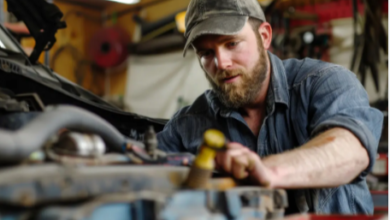How Active Release Techniques Work to Relieve Pain and Improve Mobility

Understanding Active Release Techniques
What Is Active Release Technique?
Active Release Technique, often called ART, is a hands-on treatment approach. It’s designed to tackle problems in muscles, tendons, ligaments, nerves, and fascia caused by things like overuse or injuries. Think of it as a way to manually break up scar tissue and adhesions that can limit movement and cause pain. It’s not just a massage; it’s a specific way to find and fix the root of the problem.
How Active Release Techniques Work
So, how does it actually work? Well, a trained practitioner uses their hands to feel for areas of tightness or restriction in your soft tissues. While they apply targeted pressure, you actively move the affected body part. This combination of pressure and movement helps to release the adhesions and restore normal function. It’s like ironing out wrinkles in a fabric, but for your muscles.
Targeted Relief for Muscles, Tendons, and Nerves
Active Release Technique isn’t a one-size-fits-all kind of thing. It’s very targeted. It can help with a wide range of issues, from muscle strains and tendonitis to nerve entrapments like carpal tunnel syndrome. Because it addresses the specific tissues involved, it can provide relief where other treatments might not. It’s about finding the exact source of the pain and working to correct it.
Active Release Techniques aims to restore optimal texture, motion and function of the soft tissue and release any entrapped nerves or blood vessels. By removing adhesions and scar tissue, ART allows tissues to move freely, reducing pain and improving overall function.
The Science Behind Active Release Techniques
Breaking Down Adhesions and Scar Tissue
Active Release Techniques, or ART, really gets down to the nitty-gritty of how your body moves. The main idea is to target those pesky adhesions and scar tissue that can build up in your muscles, tendons, ligaments, and nerves. Think of it like this: when you injure yourself or even just overuse a muscle, your body tries to repair the damage. Sometimes, though, it overdoes it, creating these sticky spots that limit movement and cause pain. ART practitioners are trained to find these spots and break them up using specific hand movements and pressure.
Restoring Natural Movement Patterns
So, what happens when you break up those adhesions? Well, the goal is to get your body moving the way it’s supposed to. When scar tissue restricts a muscle, it can’t lengthen and contract properly. This throws off your whole movement pattern, leading to more pain and potential injuries down the road. ART aims to restore that natural glide and slide between tissues, so your muscles can work efficiently and without pain. It’s like untangling a knot in a rope – once it’s free, the rope can move smoothly again.
Improving Circulation and Tissue Healing
Beyond just breaking up scar tissue, ART also helps to boost blood flow to the affected areas. When tissues are restricted, they don’t get the nutrients and oxygen they need to heal properly. By releasing these restrictions, ART can improve circulation, bringing in fresh blood to nourish the tissues and speed up the healing process. It’s kind of like watering a plant – if the roots are blocked, the plant can’t thrive. But once you clear the blockage, the plant can get the water it needs to grow strong again.
Think of ART as a way to reset your body’s movement patterns. It’s not just about treating the symptoms of pain, but about addressing the underlying causes and restoring proper function. By breaking down adhesions, improving circulation, and restoring natural movement, ART can help you get back to doing the things you love without pain or limitations.
Benefits of Active Release Techniques
Effective Pain Relief
Active Release Techniques can be a game-changer if you’re dealing with persistent pain. ART targets the root causes of discomfort, like muscle adhesions and nerve entrapments, offering a path to real, lasting relief. It’s not just about masking the pain; it’s about fixing the problem.
Enhancing Flexibility and Range of Motion
Ever feel stiff or limited in your movements? ART can help. By breaking down scar tissue and adhesions, ART restores your body’s natural movement patterns. This leads to increased flexibility and a wider range of motion. Think of it as WD-40 for your muscles!
Here’s how it works:
- Releases tight muscles
- Breaks down scar tissue
- Restores joint movement
Improved flexibility isn’t just about feeling good; it’s about preventing future injuries and improving your overall physical performance. When your body moves freely, you’re less likely to strain or injure yourself.
Improving Overall Physical Performance
Whether you’re an athlete or just someone who wants to move better, ART can boost your physical performance. By addressing muscle imbalances and restrictions, ART helps your body function at its best. This can translate to increased strength, speed, and endurance.
Consider these benefits:
- Increased power output
- Improved muscle coordination
- Reduced risk of injury
| Metric | Before ART | After ART | Improvement (%) |
| Range of Motion | 70 degrees | 90 degrees | 28.5% |
| Pain Level | 6/10 | 2/10 | 66.7% |
Active Release Techniques for Injury Prevention
Addressing Muscular Imbalances
Muscular imbalances are a sneaky cause of injuries. When some muscles are tight and others are weak, it throws off your body’s alignment and movement patterns. ART can help identify and correct these imbalances before they lead to bigger problems. It’s like tuning up your car before a long road trip – you want everything working smoothly to avoid breakdowns.
Minimizing Common Sports Injuries
Think about common sports injuries: hamstring strains, shin splints, rotator cuff issues. A lot of these happen because of overuse, repetitive motions, and, you guessed it, muscular imbalances. ART can be used to address these issues by:
- Releasing tension in overused muscles.
- Improving range of motion in affected joints.
- Restoring proper muscle function.
By keeping your muscles healthy and flexible, ART can significantly reduce your risk of getting sidelined by these kinds of injuries. It’s not a magic bullet, but it’s a solid preventative measure.
Proactive Muscle Health
ART isn’t just for when you’re already hurt. It can be a great way to maintain overall muscle health and prevent injuries from happening in the first place. Regular ART sessions can help:
- Keep muscles pliable and responsive.
- Improve circulation and tissue healing.
- Identify and address potential problem areas before they become painful.
It’s like going to the dentist for regular check-ups – you’re taking care of your body before something goes wrong. Think of it as an investment in your long-term physical well-being.
Active Release Techniques for Chronic Pain Management
Alleviating Lower Back and Neck Pain
Active Release Techniques (ART) can be a game-changer if you’re dealing with persistent lower back or neck pain. These issues often arise from muscle imbalances, scar tissue buildup, or nerve compression, all of which ART is designed to address. By targeting the specific tissues causing the pain, ART helps to restore proper function and reduce discomfort. It’s not just about masking the pain; it’s about fixing the underlying problem. I’ve seen it work wonders for people who’ve tried everything else.
Resolving Sciatica and Other Nerve Discomforts
Sciatica, with its radiating pain down the leg, can be debilitating. Other nerve-related issues can also cause significant discomfort and limit your daily activities. ART can help by releasing the muscles and tissues that are compressing or irritating the nerves. This can lead to a significant reduction in pain and improved nerve function. It’s like untangling a knot in a rope – once the pressure is off, things start to flow more smoothly.
Long-Term Pain Management Through Active Release Techniques
ART isn’t just a quick fix; it’s a strategy for long-term pain management. By addressing the root causes of chronic pain, ART can help you achieve lasting relief and improved quality of life. Regular sessions, combined with proper self-care, can keep those muscles and tissues healthy and prevent pain from returning. It’s about investing in your body and taking a proactive approach to your health. Plus, it can be a great complement to other therapies, like massage therapy.
ART aims to break down scar tissue, maintain muscle elasticity, and mobility if used consistently over time. While the time needed to resolve the underlying issue may vary by patient, ART’s assurance of delivering lasting pain management remains consistent.
Here’s a simple breakdown of how ART contributes to long-term pain management:
- Breaks down scar tissue that restricts movement and causes pain.
- Restores proper muscle function and reduces strain on other areas of the body.
- Improves circulation, which promotes healing and reduces inflammation.
- Addresses muscular imbalances that can contribute to chronic pain conditions.
The Active Release Techniques Session
Thorough Assessment and Evaluation
Before diving into the hands-on part of Active Release Techniques, a good practitioner will spend time figuring out exactly what’s going on with your body. This isn’t just a quick chat; it’s a detailed look at your history, how you move, and where you feel pain. They’ll probably ask a bunch of questions about your daily activities, past injuries, and anything that seems to make your pain better or worse. Then, they’ll do some physical tests to see how well your muscles and joints are working. This thorough assessment is key to creating a treatment plan that actually works for you.
Manual Therapy and Active Movement
This is where the magic happens. The practitioner uses their hands to feel for areas of tightness, scar tissue, or restrictions in your muscles, tendons, ligaments, and nerves. Once they find a problem spot, they’ll apply targeted pressure while you actively move your body in a specific way. It might feel a little uncomfortable, but it’s a “good” kind of uncomfortable, like you’re finally working something out that’s been stuck for a long time. The idea is to break up those adhesions and restore normal movement.
Personalized Treatment Application
ART isn’t a one-size-fits-all kind of thing. Your treatment will be tailored to your specific needs and the issues found during the assessment. This means the practitioner will adjust the pressure, direction, and movement based on how your body responds. They might also give you exercises or stretches to do at home to help maintain the progress you make during the session. It’s all about working together to get you feeling better and moving more freely.
Think of it like this: your body is a complex machine, and ART is like having a skilled mechanic who knows exactly how to find and fix the kinks. It’s not just about treating the symptoms; it’s about addressing the root cause of the problem so you can get back to doing the things you love without pain.
Frequently Asked Questions
What exactly is Active Release Techniques (ART)?
Active Release Techniques (ART) is a special hands-on treatment. It helps fix problems with muscles, tendons, and nerves. If these parts of your body are tight or have scar tissue, ART can help them work better and stop hurting.
How does ART actually help my body?
ART works by finding tight spots or scar tissue in your muscles and other soft tissues. A trained therapist uses their hands to press on these areas while you move your body. This helps break up the bad tissue and makes things move smoothly again.
Who can benefit from Active Release Techniques?
Lots of people can benefit! If you have muscle pain, stiffness, or trouble moving certain body parts, ART might be for you. It’s often used for athletes, but also for everyday aches like back pain or neck pain.
How many ART sessions will I need to feel better?
Many people feel better after just a few sessions. How long it takes depends on what’s wrong and how bad it is. Your therapist will tell you what to expect.
Is ART safe, and does it hurt?
ART is generally safe when done by a trained and certified therapist. You might feel a little discomfort during the treatment, but it’s usually not painful. Some people feel a bit sore afterward, like after a good workout.
Can ART help me avoid future injuries?
Yes, ART is great for preventing injuries! By fixing small muscle problems before they become big ones, ART helps keep your body balanced and working well, reducing your chances of getting hurt.




